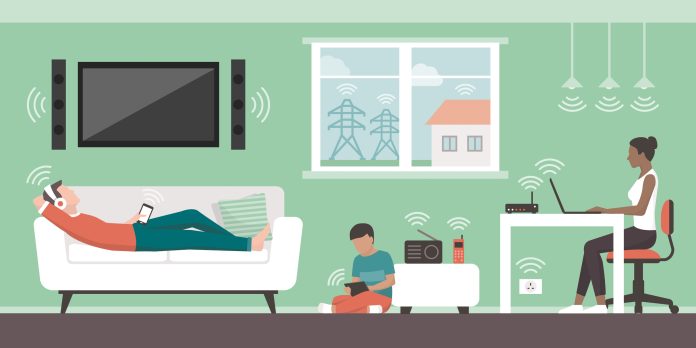Sarah Scott is a freelance journalist and Acting Trustee for the UK charity MCS-Aware, which supports people with environmental illness. Here, she discusses potential health threats inherent in the rapidly growing global reliance on wireless technology and why more research is urgently needed to better understand the effects of EMF exposure
EMFs (electromagnetic fields) are generated whenever we use electricity and electronic devices, meaning we are now surrounded by an invisible cloud of electrosmog, which has increased dramatically since the early 20th century.
How we’re exposed to EMF pollution
Whilst cavemen were exposed to a small quantity of background radiation from the sun and the Earth’s natural magnetic field, human-generated EMF pollution only developed from around the 1930s onwards, with the introduction of electricity distribution networks, radio and TV masts, mobile phone masts, and now thousands of GPS/communication satellites circling the planet. The result is that average levels of EMFs have skyrocketed in comparison to the natural background radiation experienced by our ancestors only a few hundred years ago.
EMFs comprise extremely low-frequency (ELF) electric and magnetic fields, created by overhead power lines, electrical wiring, and household appliances (such as hairdryers, TVs, and kettles), along with higher radio frequency (RF) waves employed by communication devices and networks, including wireless routers, computers, tablets, and smartphones.
Both ELF and RF constitute non-ionising radiation (differentiated from ionising radiation, such as X-rays and nuclear radiation, which is already known to cause cancer at high exposure levels by damaging cells).
Are EMFs a health threat?
International regulatory bodies have consistently stated that low-intensity RF radiation – as used by wireless devices and networks – is not believed to be carcinogenic at levels not strong enough to heat body tissues (i.e. ‘non-thermal’ effects) within current safety guidelines. There is, however, a recognised weak association between exposure to the magnetic fields created by high-voltage electricity pylons (ELF) and an increased risk of developing childhood leukaemia. (1)
Nevertheless, both RF and ELF radiation are currently listed by the World Health Organization’s IARC (International Agency for Research on Cancer) as Group 2B ‘possible’ carcinogens, based on a small number of studies showing cancer-causing effects in humans (ELF since 2002, RF since 2011).
Several international scientists are now calling for RF to be classified as a Group 2A (‘probable’) carcinogen, or even upgraded to Group 1 (‘carcinogenic’), (2) based on recent findings including a landmark 2018 $25million US Government-funded study, which found ‘clear evidence’ that RF radiation had caused cancer in rats (of a similar type to that previously detected in a limited number of human epidemiological studies). (3)
Numerous other research studies published in peer-reviewed scientific journals over the years have found negative health effects from EMF exposure, in areas ranging from functional disorders – such as depression, (4) memory impairment (5,6) and sleep disruption (7, 8) (insomnia is now estimated to affect approximately a third of the UK population) (9, 10) – to permanent cognitive decline, such as increased dementia and Alzheimer’s risk. (11, 12, 13)
Whilst frequent reference is made in mainstream media to exposure to the blue-spectrum light emitted by wireless devices’ screens prior to bedtime adversely affecting sleep – due to its known effect on melatonin levels – it is surprising that, simultaneously, there is little mention of any potential impact of the RF exposure from these devices on sleep, found by some studies to suppress melatonin too (a hormone which, moreover, plays a protective role in cancer prevention). (14 15)
EMFs have also been linked to a greater incidence of autism symptoms by some research (16) at a time when issues with poor concentration amongst the younger generation and ADHD diagnoses are at an all-time high.
In addition, a review conducted by Dr Henry Lai, emeritus professor in bioengineering at the University of Washington, which examined over 2500 studies into ELF and RF exposure, published between 1990 and 2025, has found that between 70-91% of the published research reported significant biological effects in areas including reproduction, neurology, genetic (DNA) damage, and oxidative (free radical) effects on cellular processes. (17)
There have also been a number of purported effects of EMF exposure on nature and wildlife, including damage to the bark and leaves of trees in urban areas with high RF levels, (18) an impact on the ability of birds and bees exposed to EMFs to navigate, (19, 20) and bee colony collapse. (21)
Revising guidelines to address potential non-thermal health effects
Whilst many thousands of studies (including those referenced) have found a clear association between low-level RF exposure and negative health impacts, in both humans and the natural world, some others (especially industry-sponsored research) have not. This has allowed governments and international protection bodies (such as ICNIRP, the International Commission on Non-Ionising Radiation Protection) to continue to maintain that, overall, the ‘balance of evidence’ suggests that ‘health effects are unlikely to occur if exposures are below international guideline levels.’ (22 23)
However, ICNIRP has faced criticism from many within the scientific community for perceived bias towards the tech industry, (24) for consistently failing to appoint members prepared to fully consider the existence of non-thermal effects at lower exposure levels, (25) and for setting international guidelines accordingly. (26)
There are now growing calls from numerous scientists around the world for ICNIRP’s RF guidelines to be revised and significantly lowered, to reflect emerging evidence of harm from non-thermal health effects, rather than being based solely and dogmatically on long-established heating/thermal effects, which occur at higher exposure levels. (27)
Electromagnetic hypersensitivity (EHS)
Leaving aside the potential carcinogenic or general health effects of EMFs, there is also a subset of the population who consistently report issues with everyday exposure to ELF and RF radiation, namely people with electromagnetic hypersensitivity (EHS). Symptoms are varied but can include headache, tinnitus, dizziness, ‘pressure in the head’, tingling sensations, skin disorders, nausea, heart palpitations, immune dysfunction, cognitive impairment – including memory loss, poor concentration, brainfog – insomnia and depression. (28)
Many EHS sufferers are unable to use wireless devices at all. They can become isolated, housebound, and unable to work, with some even becoming homeless, due to background RF emissions from neighbours’ Wi-Fi routers and devices such as smart meters. (29) In extreme cases, especially where official recognition and support are lacking, people have resorted to taking their own lives as a result of the condition. (30)
Estimates for the prevalence of EHS – based on geographical surveys – vary widely, from 2.7% of the population (Sweden, 2018) to 13.3% (Taiwan, 2011), (31) most likely reflecting differing survey methodology and the range between those most severely affected, at the lower end, compared to those more moderately affected.
Globally, the overall number of sufferers could total hundreds of thousands, if not millions, with support groups existing in many countries worldwide, including, among others, the UK (MCS-Aware and ES-UK), Sweden, Finland, the US, Japan, Canada, Australia, France, Germany, and Italy.
EHS is poorly recognised in the UK. In a press release related to a 2005 review of EHS, the former Health Protection Agency (HPA) acknowledged that ‘people complaining of the condition can experience real, unpleasant, and sometimes disabling symptoms.’ (32) However, a subsequent report, completed in 2012, concluded that ‘taken together, the literature does not support the hypothesis that some people are able to detect RF fields.’ (33)
This is primarily due to the fact that numerous provocation studies have failed to find conclusive results – the condition is extremely hard to study under laboratory conditions due to lack of control of background radiation, and the non-linear nature of symptoms, which often have a delayed onset following exposure of hours or even days – in the same way that it would be hard to switch hay-fever symptoms on and off repeatedly following pollen exposure.
A pilot study conducted in 2017, led by Dr Gunnar Heuser, found some evidence of increased hyperconnectivity/abnormalities in functional MRI brain scans of individuals reporting EHS, compared to healthy controls. (34) But there has been little funding for further research since then.
Other studies have proposed potential causal factors of myelin damage in the nerve tissue of EHS sufferers, (35) along with the possible involvement of magnetite particles in the brains of those who are sensitised (used by birds and other species to navigate in relation to the Earth’s magnetic field). (36)
Greater recognition is given to EHS in countries such as Sweden, where the condition is categorised as a ‘functional disability.’ One high-profile sufferer includes Dr Gro Harlem Brundtland, a former three-term Prime Minister of Norway, a medical doctor, and Director-General of the World Health Organization (1998-2003).
In 2011, the Council of Europe – of which the UK is still a member – passed resolution 1815 stating that governments should take a precautionary approach to the roll-out of wireless technologies and, amongst other measures, that Member States should provide Wi-Fi-free areas for citizens with EHS in which to live and work, (37) but the UK Government has yet to act on this advice.
Interestingly, guidance principles related to exposure limits issued by ICNIRP in 2020 do recognise that biological effects can result from exposure to non-ionising EMFs, and that such effects may ‘vary depending on individual sensitivity to specific situations.’ For example, they include: ‘a tingling sensation resulting from peripheral nerve stimulation by electric or magnetic fields’ and ‘microwave hearing resulting from thermoelastic waves due to expansion of soft tissues in the head which travel via bone conduction to the inner ear.’ (38)
These sensory effects sound very similar to symptoms reported by people with EHS at low levels of exposure. However, whilst ICNIRP acknowledges that ‘such perceptions may sometimes lead to discomfort and annoyance’, it does not consider biological effects to be health effects as such – other than by an indirect route of these ‘annoyances’ compromising wellbeing, which seems a perverse distinction to make in the circumstances.
Protecting yourself against EMFs
In the absence of effective precautionary measures taken by the majority of governments, or widely publicised official warnings to the public to limit exposure to EMFs, and with research ongoing, some individuals and institutions may wish to take a preventative approach to the use of electrical appliances and wireless gadgets – either as a protective measure against any potential increased long-term health risks, or as a direct result of experiencing symptoms (such as with EHS).
This is especially so as most official exposure guideline limits (set by ICNIRP, but implemented differentially by international governments) remain well above the levels of RF which have been linked to adverse health effects by some research studies, and which can be generated 24/7 by wireless devices, even when not in use or in standby mode.
Precautionary measures could include keeping the bedroom environment free of electrical equipment, switching off devices such as Wi-Fi routers and smartphones overnight and/or using a fully-wired ethernet network with (wireless-disabled) laptops and PCs (via a USB/ethernet adaptor and cable, connected directly to the ethernet port of a Wi-Fi-disabled router). Smartphones (and tablets) can also be used in ‘airplane’ mode to access the internet from static locations (ensuring Bluetooth is also disabled in settings) by utilising a Lightning (Apple) or USB-C (Android) ethernet adapter/cable.
Smart meters are not currently a legal requirement in the UK (existing smart electric meters can – in theory – be set by the utility supplier to operate in ‘dumb’ mode, or new meters fitted without the separate communications hub they are supplied with), and it is usually possible to turn off wireless networks on other electronic equipment, such as smart TVs and DVD/hard-drive-recorders, via the settings.
Wearable tech, such as smartwatches and fitness trackers, should ideally be avoided altogether, as these devices emit a constant stream of RF radiation – via Wi-Fi and Bluetooth signals – directly next to the body, which can’t always be fully disabled.
Given the rapidly increasing global dependency on wireless technology and the huge potential impact on public health, it is vital that, as a matter of urgency, further in-depth research is carried out into the long and short-term health effects of universal EMF exposure, and that international governments provide proper assistance and recognition to those people already reporting symptoms.
References
- Draper G, Vincent T, Kroll ME, Swanson J. Childhood cancer in relation to distance from high voltage power lines in England and Wales: a case-control study. BMJ. 2005 Jun 4;330(7503):1290. doi: 10.1136/bmj.330.7503.1290
- Environmental Health Trust: https://ehtrust.org/science/whoiarc-position-on-wireless-and-health/
- National Toxicology Program: https://ntp.niehs.nih.gov/research/topics/cellphones
- Wilson BW. Chronic exposure to ELF fields may induce depression. Bioelectromagnetics. 1988;9(2):195-205. doi: 10.1002/bem.2250090211
- Wang B, Lai H. Acute exposure to pulsed 2450-MHz microwaves affects water-maze performance of rats. Bioelectromagnetics. 2000 Jan;21(1):52-6. PMID: 10615092
- Foerster M, Thielens A, Joseph W, Eeftens M, Röösli M. A Prospective Cohort Study of Adolescents’ Memory Performance and Individual Brain Dose of Microwave Radiation from Wireless Communication. Environ Health Perspect. 2018 Jul 23;126(7):077007. doi: 10.1289/EHP2427
- Arnetz, Bengt & Åkerstedt, Torbjörn & Hillert, Lena & Lowden, Arne & Kuster, Niels & Wiholm, Clairy. (2007). The Effects of 884 MHz GSM Wireless Communication Signals on Self-reported Symptoms and Sleep (EEG) – An Experimental Provocation Study. Piers Online. 3. 1148-1150. doi: 10.2529/PIERS060907172142
- Bijlsma N, Conduit R, Kennedy G, Cohen M. Does radiofrequency radiation impact sleep? A double-blind, randomised, placebo-controlled, crossover pilot study. Front Public Health. 2024 Oct 29;12:1481537. doi: 10.3389/fpubh.2024.1481537
- de Lange MA, Richmond RC, Eastwood SV, Davies NM. Insomnia symptom prevalence in England: a comparison of cross-sectional self-reported data and primary care records in the UK Biobank. BMJ Open. 2024 May 7;14(5):e080479. doi: 10.1136/bmjopen-2023-080479
- ‘Hospital attendances in England for children under 14 with sleep disorders have tripled in 10 years, according to NHS data analysed by BBC Panorama’ – Sleepless Britain, March 2017, https://www.bbc.co.uk/news/health-39140836
- Röösli M, Lörtscher M, Egger M, Pfluger D, Schreier N, Lörtscher E, Locher P, Spoerri A, Minder C. Mortality from neurodegenerative disease and exposure to extremely low-frequency magnetic fields: 31 years of observations on Swiss railway employees. Neuroepidemiology. 2007;28(4):197-206. doi: 10.1159/000108111
- García AM, Sisternas A, Hoyos SP. Occupational exposure to extremely low frequency electric and magnetic fields and Alzheimer disease: a meta-analysis. Int J Epidemiol. 2008 Apr;37(2):329-40. doi: 10.1093/ije/dym295
- Huss A, Spoerri A, Egger M, Röösli M; Swiss National Cohort Study. Residence near power lines and mortality from neurodegenerative diseases: longitudinal study of the Swiss population. Am J Epidemiol. 2009 Jan 15;169(2):167-75. doi: 10.1093/aje/kwn297
- Kim HS, Paik MJ, Lee YH, Lee YS, Choi HD, Pack JK, Kim N, Ahn YH. Eight hours of nocturnal 915 MHz radiofrequency identification (RFID) exposure reduces urinary levels of melatonin and its metabolite via pineal arylalkylamine N-acetyltransferase activity in male rats. Int J Radiat Biol. 2015;91(11):898-907. doi: 10.3109/09553002.2015.1075075
- Mortazavi SAR, Mortazavi SMJ. Women with hereditary breast cancer predispositions should avoid using their smartphones, tablets, and laptops at night. Iran J Basic Med Sci. 2018 Feb;21(2):112-115. doi: 10.22038/IJBMS.2018.27711.6751
- Mariea TJ, Carlo GL (2007) Wireless radiation in the etiology and treatment of autism: clinical observations and mechanisms. J Aust Coll Nutr Env Med 26(2):3–7 https://search.informit.org/doi/10.3316/informit.540847291544668
- https://www.saferemr.com/2018/02/effects-of-exposure-to-electromagnetic.html
- https://www.latimes.com/archives/blogs/technology-blog/story/2010-11-23/wi-fi-could-be-harmful-to-trees-cause-bleeding-and-bark-tears-study-says
- Warnke, Ulrich. (2008): https://www.researchgate.net/publication/241538484_BEES_BIRDS_AND_MANKIND
- Kimmel, Stefan & Kuhn, Jochen & Harst, Wolfgang & Stever, Hermann. (2007). Electromagnetic radiation: Influences on honeybees (Apis mellifera). IIAS-InterSymp Conference. Baden-Baden. 1-6
- Sharma, vp & Kumar, Neelima R. (2010). Changes in honey bee behaviour and biology under the influence of cell phone radiation. Current science. 98. 1376-1378
- https://www.gov.uk/government/publications/mobile-phone-base-stations-radio-waves-and-health
- https://www.icnirp.org/en/frequencies/radiofrequency/index.html
- https://www.rfsafe.com/the-icnirps-industry-ties-a-case-for-biased-wireless-safety-guidelines/
- https://radiationprotection.se/eu/the-eu-commission-selected-biased-experts-for-radiation-report/
- Nordhagen EK, Flydal E. Self-referencing authorships behind the ICNIRP 2020 radiation protection guidelines. Rev Environ Health. 2022 Jun 27;38(3):531-546. doi: 10.1515/reveh-2022-0037
- https://emfscientist.org/
- https:www.powerwatch.org.uk/health/sensitivity.asp
- Hanotiaux, Gérald (2020-2023). Social Exclusion due to Electromagnetic Pollution: A Belgian Perspective: https://www.es-uk.info/wp-content/uploads/2024/09/ES_WEB_240908.pdf
- https://www.independent.co.uk/news/uk/home-news/school-girl-found-hanged-after-suffering-from-allergy-to-wifi-a6755401.html
- Lu, X, Hojo, S, Mizukoshi, A. et al. Prevalence and correlation of multiple chemical sensitivity and electromagnetic hypersensitivity with age, sex, and depression in the Japanese population: a retrospective study. BMC Public Health, 23, 1205 (2023). https://doi.org/10.1186/s12889-023-16152-2
- Irvine, N. (2005): https://www.gov.uk/government/publications/electrical-sensitivity-definition-epidemiology-and-management
- Report of the independent Advisory Group on Non-ionising Radiation (2012): https://assets.publishing.service.gov.uk/media/5a7e0ebded915d74e6223d46/RCE-20_Health_Effects_RF_Electromagnetic_fields.pdf
- Heuser, Gunnar and Heuser, Sylvia A. Functional brain MRI in patients complaining of electrohypersensitivity after long term exposure to electromagnetic fields. Reviews on Environmental Health, vol. 32, no. 3, 2017, pp. 291-299. https://doi.org/10.1515/reveh-2017-0014
- Redmayne M, Johansson O. Could myelin damage from radiofrequency electromagnetic field exposure help explain the functional impairment electrohypersensitivity? A review of the evidence. J Toxicol Environ Health B Crit Rev. 2014;17(5):247-58. doi: 10.1080/10937404.2014.923356.
- Henshaw DL, Philips A. A mechanistic understanding of human magnetoreception validates the phenomenon of electromagnetic hypersensitivity (EHS). Int J Radiat Biol. 2025;101(2):186-204. doi: 10.1080/09553002.2024.2435329
- Resolution 1815 (2011) – The potential dangers of electromagnetic fields – Parliamentary Assembly of the Council of Europe (PACE): https://assembly.coe.int/nw/xml/XRef/Xref-XML2HTML-en.asp?fileid=17994
- International Commission on Non-Ionising Radiation Protection (ICNIRP). Principles for Non-Ionising Radiation Protection. Health Phys. 2020 May;118(5):477-482. doi: 10.1097/HP.0000000000001252











